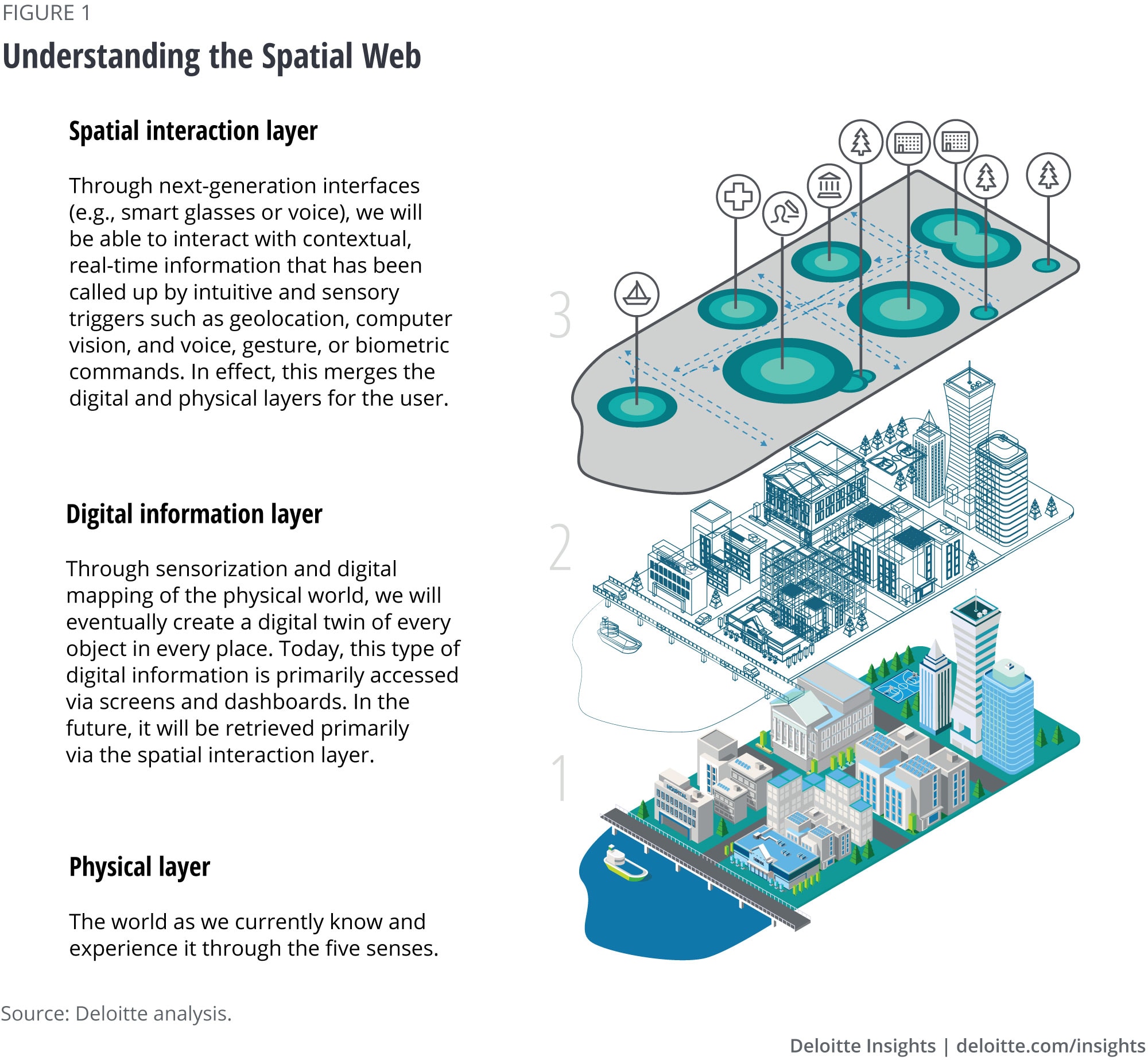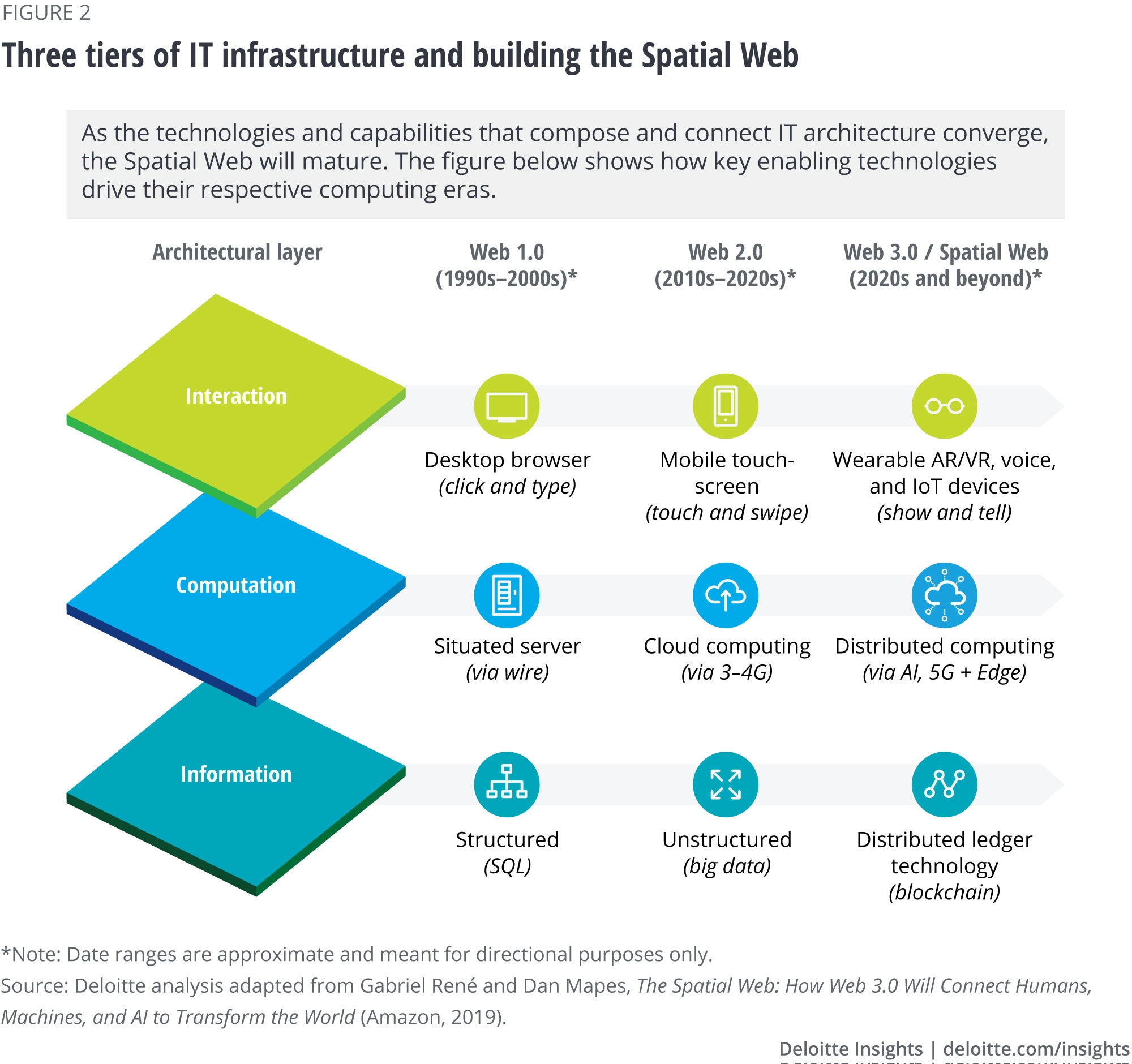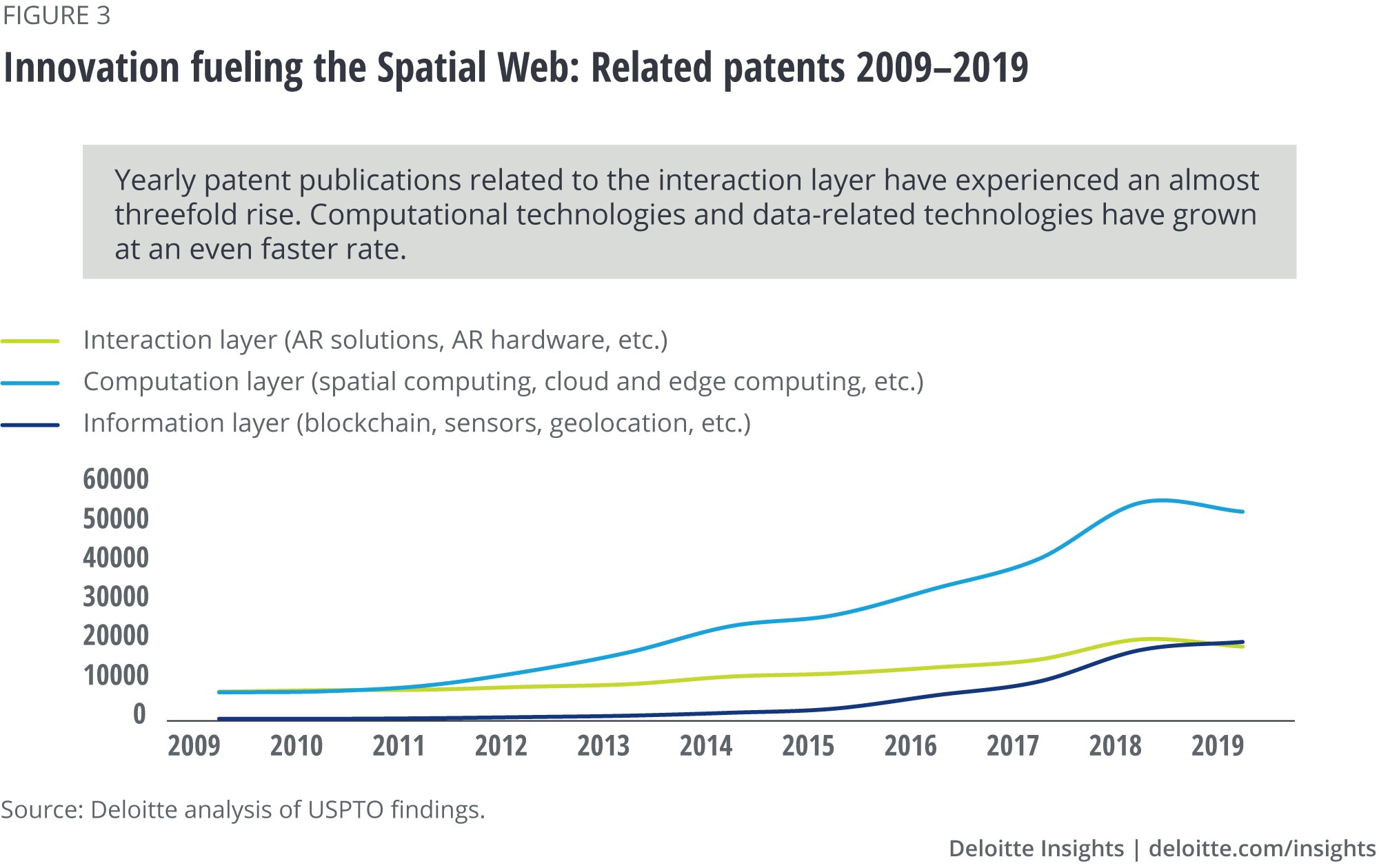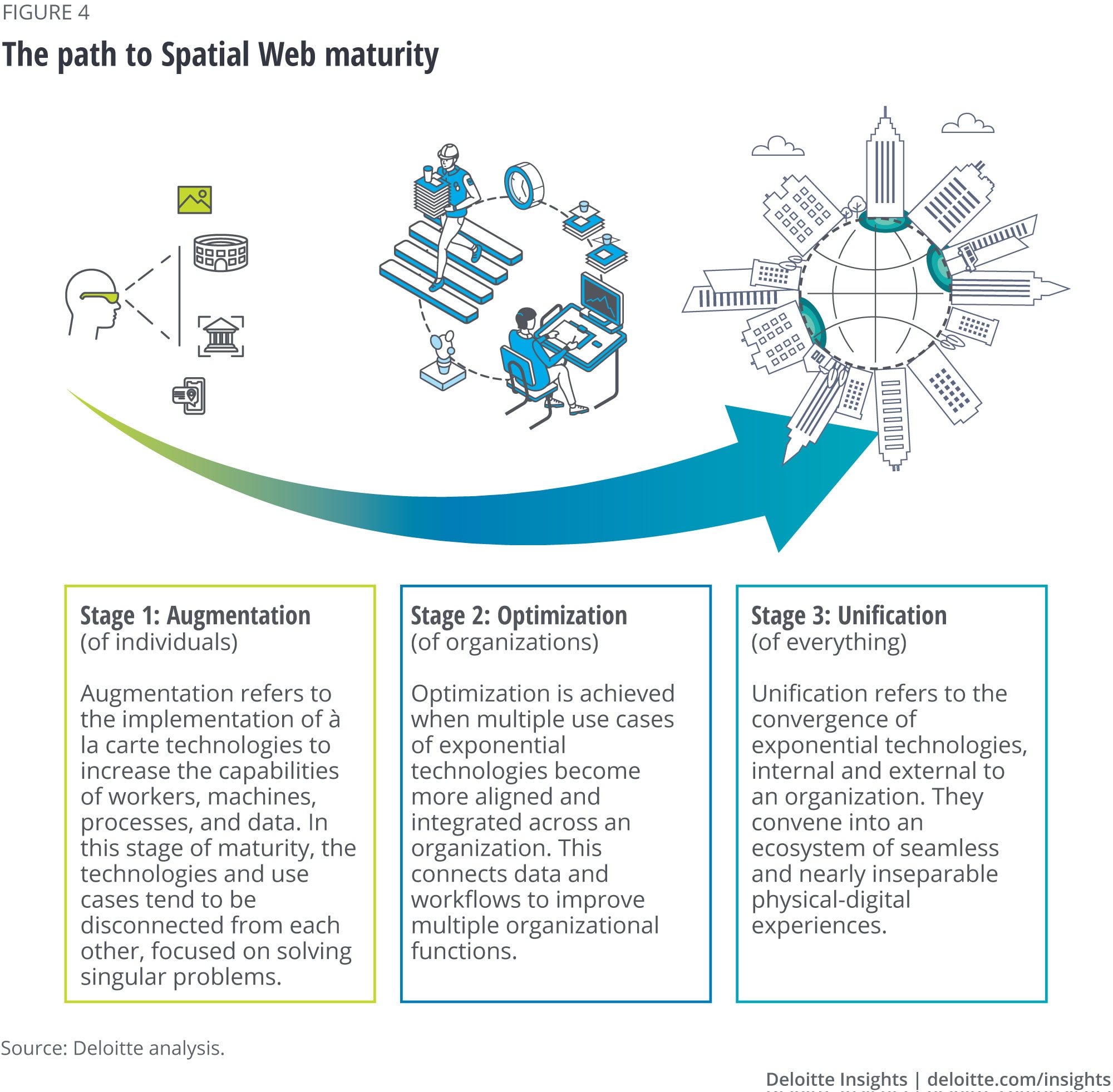
The Spatial Web and Web 3.0 What business leaders should know about the next era of computing
22 minute read
21 July 2020
As futuristic as it sounds, early-stage applications of the Spatial Web or Web 3.0 are already here. Now is the time for leaders to understand what this next era of computing entails, how it could transform businesses, and how it can create new value as it unfolds.
Introduction
The once-crisp line between our digital and physical worlds has already begun to blur. Today, we hear of surgeons experimenting with holographic anatomic models during surgical procedures.1 Manufacturing, maintenance, and warehouse workers are measuring significant efficiency gains through the use of the Internet of Things (IoT) and augmented reality.2 Cities are creating entire 3D digital twins of themselves, helping to improve decision-making and scenario-planning.3 Still, there’s a sense that we’re not “there” yet.
Learn more
Explore the Digital transformation collection
Explore the Emerging technologies collection
Learn about Deloitte's services
Go straight to smart. Get the Deloitte Insights app
Today’s technology applications are just glimmers of the emerging world of the Spatial Web, sometimes called Web 3.0, or the 3D Web (see sidebar, “Emerging definitions: Web 3.0 and the Spatial Web”). It is the next evolution in computing and information technology (IT), on the same trajectory that began with Web 1.0 and our current Web 2.0. We are now seeing the Spatial Web (Web 3.0) unfold, which will eventually eliminate the boundary between digital content and physical objects that we know today. We call it “spatial” because digital information will exist in space, integrated and inseparable from the physical world. (To read an example of how it might work in reality, see the sidebar, “A vision of the Spatial Web in health care.”)
This vision will be realized through the growth and convergence of enabling technologies, including augmented and virtual reality (AR/VR), advanced networking (e.g., 5G), geolocation, IoT devices and sensors, distributed ledger technology (e.g., blockchain), and artificial intelligence/machine learning (AI/ML). While estimates predict the full realization of the Spatial Web may be 5–10 years away, many early-stage applications are already driving significant competitive advantage.4
We are now seeing the Spatial Web unfold, which will eventually eliminate the boundary between digital content and physical objects that we know today.
By vastly improving intuitive interactions and increasing our ability to deliver highly contextualized experiences—for businesses and consumers alike—the Spatial Web era will spark new opportunities to improve efficiency, communication, and entertainment in ways we are only beginning to imagine today. For forward-thinking leaders, it will create new potential for business advantage—and, of course, new risks to monitor.
In this article, we will define the vision for the Spatial Web, discuss the technologies it is built upon, and describe the path to maturity. The goal for most companies is not to build a Spatial Web; however, understanding its capabilities can help leaders better prepare for the long term, get more out of their current investments in the short term, and participate in critical conversations happening today that could decide how this coming era affects both business and society.
EMERGING DEFINITIONS: WEB 3.0 AND THE SPATIAL WEB
“...the world around us is about to light up with layer upon layer of rich, fun, meaningful, engaging, and dynamic data. Data you can see and interact with. This magical future ahead is called the Spatial Web and will transform every aspect of our lives, from retail and advertising, to work and education, to entertainment and social interaction.”—Peter Diamandis5
There is no single definition for Web 3.0, the computing era that follows our current, mobile-powered Web 2.0. Many people identify Web 3.0 with the Semantic Web, which centers on the capability of machines to read and interact with content in a manner more akin to humans.6 Recently, definitions of Web 3.0 have begun to include distributed ledger technologies, such as blockchain, focusing on their ability to authenticate and decentralize information. Theoretically, this could remove the power of platform owners over individual users.7
Each of these perspectives begins to describe a similar end state; they just start from different technology vantage points. We use the term “Spatial Web” because it emphasizes the shift in experience for the end user by transferring interaction with information away from screens and into physical space (figure 1).

A VISION OF THE SPATIAL WEB IN HEALTH CARE
Step a few years into the future, where connectivity, processing power, digital devices, and our ability to analyze and contextualize data have advanced considerably. In this world, much of our interaction with digital information happens away from traditional screens, tablets, and phones. Here, we meet a leading heart surgeon and researcher of cardiovascular health. She is starting her day, not by checking her phone, but by turning on her hands-free, intelligent interface.8 This advanced device curates multiple media channels that filter contextual information into her field of view, from social media and the news to her work schedule and secure patient information. This morning, she uses it to call a self-driving car to take her to the hospital; on the way, she attends a brief, holographic video conference with her child’s teacher. As the car reaches the hospital, the device shifts settings to enable a secure and rich mixed-reality medical environment, lowering the priority of notifications from her personal life.
She begins work by digitally “scrubbing in” for robotic surgery on a patient thousands of miles away.9 In this procedure, she will virtually guide her onsite human and robotic colleagues, who are present with the patient in the physical operating room. She’ll administer the procedure using combinations of “see-what-I-see” features, haptic-enabled and custom 3D-printed surgical instruments, and hands-free digital models. But before they begin, the team virtually convenes around a 3D digital twin of the patient’s heart.10 This exact digital replica has been a valuable tool in helping establish a surgical plan; thus far, it has been used to collaboratively monitor the patient’s condition, customize the surgical implants,11 and help the patient visualize the procedure. As the team moves into surgery, this digital twin provides real-time, AI-supported insights on the patient’s condition, poised to alert the surgical staff to potential alternate interventions. Fortunately, this surgery goes as planned; our surgeon successfully completes the procedure, and onsite colleagues close the patient for recovery.
As the team finishes, data from the procedure is collected, analyzed, and collated for a variety of purposes, based on the need and security permissions of whoever is accessing it. It will be used to support the individual patient’s postoperative care team; other parts of the health system may simultaneously draw off the same database using the billions of data points to help monitor public health and system capacity, run simulations, and improve outcomes.12
We are already seeing the early signs of this imagined future, although the interconnected network required across patient care, R&D, hospital systems, and other supportive industries may be a number of years away. However, we can see the value of these new interfaces and digital threads intertwining seamlessly for more effective results, both for the individual and the system. This integrated physical and digital network is expected to be constructed over time, built on the convergence of advanced technologies layered and designed both securely and interoperably.13
Building the Spatial Web
While we can’t predict precisely when Spatial Web maturity will arrive, the trend line toward this future has been emerging for decades. Just as earlier capabilities gave rise to Web 1.0 and Web 2.0, today’s leading technologies are fueling and informing the evolution into the Spatial Web as they advance across the three basic tiers of IT architecture (see figure 2):
- Interaction: The software, hardware, and content that we ultimately interact with
- Computation: The logic that enables the interaction
- Information: The data and structure that allow computational functions to be completed accurately, efficiently, and securely

Gabriel René, executive director of the Spatial Web Foundation, notes: “Downstream of these technology investments are the combinatorial benefits that come when you are not implementing them entirely separately, but as part of a larger strategy. This is how we upgrade to Web 3.0.”14
“Downstream of these technology investments are the combinatorial benefits that come when you are not implementing them entirely separately, but as part of a larger strategy. This is how we upgrade to Web 3.0.”—Gabriel René, executive director of the Spatial Web Foundation
Interaction: AR/VR devices are expected to be a primary gateway for humans to access the Spatial Web, although form factor may eventually range from AR glasses or digital contact lenses to haptic wearables, IoT devices, sensors, robots, autonomous vehicles, and beyond. For the Spatial Web to become widely adopted, AR interfaces in particular will need to become more affordable and comfortable to wear for long periods of time.
In recent years, significant investments have occurred in this area. Traditional incumbents, such as Google,15 are continuing to develop and evolve AR hardware. Facebook—an active participant in the VR space since its US$2 billion acquisition of Oculus VR in 2014—has recently made a slew of investments focused on AR and the AR Cloud, including a project called Live Maps that will reportedly create shared 3D maps of the world.16 Apple17 has been developing its own light-weight AR glasses and has applied for a series of patents that could significantly reduce the size of such AR devices.18
Zooming out to look at the broader tech industry, we see upward trends in innovation and development of technologies supporting the interaction layer of the Spatial Web. For example, the number of AR-related patents published yearly in the United States grew more than threefold over the last ten years (see figure 3).19
Computation: AI/ML will play a foundational role in Spatial Web computation. It enables machines and devices to understand the nondigital world, for example, via computer vision and natural language processing. It will also drive contextual, personalized experiences via AI’s ability to self-program, continuously learn, and make contextual decisions. This will be critical for Spatial Web maturity, and it will require immense amounts of processing power. In addition, to rapidly and securely transmit rich, high-definition, contextual media experiences from physical objects to a computation layer and back to the end user, extremely fast network connectivity will be required. All of this will depend on high-bandwidth networks and more distributed locations for computing, making 5G connectivity and Edge computing core enablers.
Edge computing helps to reduce latency by decreasing the distance between the device and a cloud-based processor.20 5G, which can enable download speeds up to 100 times faster than 4G,21 has seen a high level of investment in recent years, driving predictions that the number of connections could grow from roughly 10 million in 2019 to over 1 billion in 2023, representing just under 10% of all mobile device connections.22 Recent economic shifts may slow this over the short term; however, as of January 2020, 5G had already been deployed in 378 cities across 34 countries.23
A key infrastructure to support this level of computation is the AR Cloud (see sidebar, “AR Cloud and 3D-mapping the physical world”).24 This will require technology ranging from machine vision to 3D modeling technologies that will allow the creation, positioning, and anchoring of digital content over physical objects.
Information: Data sources and types are increasing constantly and will only accelerate as sensorized devices proliferate. This makes privacy a critical consideration, and it is why many consider distributed ledger technologies, such as blockchain, to be foundational.25 Through built-in immutability, data integrity and security are ensured, allowing platforms or companies to incorruptibly manage access and identity control.26 Because of this, blockchain’s authentication abilities can enable open ecosystems, without restricting users, as many platform-based applications do today. This ability to decentralize spurs the hope that the Spatial Web will realize the vision of a truly open and democratized internet.27
Apart from its security capabilities, blockchain also plays a role in managing entities in the physical world—from buying location-based digital real estate to managing nonprivate spaces such as parks and even nongovernmental locations such as oceans. One company, XR Web, has already started selling spaces on the Earth's digital layer.28
All told, this is a story of technology converging across the three layers of IT. We see measurable innovation across all three tiers discussed in this section. Patent publications are typically considered a good indicator of innovation activity and investments, and applications related to Spatial Web technologies have shown clear growth over the last decade (see figure 3). While not all of these patents are exclusive to the Spatial Web, every innovation can help in its eventual realization. Furthermore, Spatial Web–specific patents (those that specifically mention Spatial Web, AR cloud, or 3D Web) have demonstrated a tenfold increase in the last 10 years.29

AR CLOUD AND 3D-MAPPING THE PHYSICAL WORLD
The AR Cloud is a key enabler of the Spatial Web; some groups even use both terms interchangeably. According to the Open AR Cloud association (OARC), the simplest definition of the AR Cloud is a 3D digital copy of the world.30 By creating 1:1 scale digital models that are machine-readable, updated in real time, and associated with precise geolocation information, spatial experiences can become richer, more accurate, and more connected. Ultimately, its creation helps enable our ability to fully erase the line between digital and physical objects. Today, a variety of companies are working toward its development.
Maps of physical spaces and digital twins will be created for everything: cities, rooms, retail spaces, public areas. Once maps are built, locations could be defined in space and new types of transactions and interactions become possible. As people and objects begin to move through these maps, it should become possible to gather a wealth of previously unavailable information about people and processes: how they gather, move, and interact, and which experiences they find useful.
Getting from here to there: A path to the mature Spatial Web
As described in the previous section, the Spatial Web will require advances in all three tiers of IT infrastructure to come to full fruition. The path to maturity can be viewed in three general stages: Augmentation, Optimization, and Unification (see figure 4). While the Unification stage is still estimated to be a few years away, many companies are already generating value through the Augmentation and Optimization phases.

In the first stage, Augmentation, organizations implement technologies to “augment” the capabilities of workers, machines, and processes. They tend to be disconnected from each other, and workflows remain largely the same as before.
Most industries are already at this stage, implementing technologies such as AR to support frontline workers in manufacturing, maintenance, and field service;31 VR learning to support difficult, expensive, or dangerous skill development; 32 and the IoT to drive predictive maintenance.33 These use cases are already demonstrating valuable returns for companies—for example, one company compared AR line-of-sight instructions to using a traditional manual for wind turbine assembly. Using the AR workflow, technician performance improved by 34%.34
Through successful applications, organizations lay the foundation for the second stage, Optimization, where use cases become more integrated and cross-functional. For example, in earlier stages of maturity, a digital twin could allow factory engineers to move from reactive to predictive equipment maintenance.35 As the organization becomes more sophisticated, it begins to integrate data and identify opportunities for cross-functional optimization via a broader asset performance management (APM) system. APM helps inform not just maintenance timing, but also operational procedures, and material and part procurement, which can lead to gains across the enterprise—from material spend to savings on insurance premiums resulting from deep reductions in catastrophic failures.36
In another example of organizational optimization, Wayfair saw the opportunity for AR to help customers visualize and place furniture in their homes.37 While the company measured significant boosts in conversion and reduced returns as a result of the experience, the time and effort in creating high-quality 3D product models spurred it to look for additional uses. Today, almost its entire online catalog is created using those 3D models, instead of standard photography. The level of cost savings from catalog and marketing asset production has unlocked value and further investment in 3D experiences across the company.38
The third stage, Unification, is when the more complete vision of the Spatial Web emerges, as technologies and ecosystems converge. While the earliest manifestations have been seen in gaming, a number of 3D-specific startups such as Ubiquity639 and WRLD,40 in addition to long-standing companies such as Esri,41 are actively developing spatial capabilities for broader enterprise and consumer applications. Ultimately, these companies are looking for a platform that helps everyone move seamlessly from context to context, with the right data and experiences available at the right time and location.
There is a lot of conjecture about how the mature Spatial Web will manifest. Possibilities range from a completely open-source, democratized Spatial Web that anyone can join (irrespective of device) to platform-defined, walled-garden Spatial Web(s) that are owned and governed by a small number of large companies. The way technology advances and which group defines the Spatial Web will have enormous influence over how this new world unfolds—and the vast amounts of data it will generate.
Many early proponents are hopeful that the mature Spatial Web will embody a return to the early vision of “universality,” inspired and driven by World Wide Web inventor Tim Berners-Lee.42 They argue that Web 1.0 became possible and valuable because of the network effect and innovation its openness welcomed through the establishment of open web standards. Although Web 2.0 made user-generated content easier and, some may say, democratic, the heavily private and app-driven networks have foregone openness.43 This has made it difficult for users to switch platforms and has reduced the interoperability of today’s digital interactions. Many argue this impedes innovation and consumer control.44 This is why at this early stage of the Spatial Web/Web 3.0, a number of groups, including Open AR Cloud, IEEE, and the Spatial Web Foundation, are pushing to create open standards that will realign behind a decentralized and democratic set of values.45
Standards-setting may sound dry, but it is central to determining the future of the Spatial Web—and who will control the vast amounts of data it generates. The outcome will have significant implications economically, socially, and ethically (see sidebar, “Ethics and privacy challenges in the Spatial Web”). This is why it is so important for all types of companies to participate in creating these standards.
ETHICS AND PRIVACY CHALLENGES IN THE SPATIAL WEB
Experiences available on the Spatial Web could sway our view of reality to a degree never before seen. Ethical issues related to fair and responsible data usage, as well as privacy, ownership, security, and authentication are paramount.
This is a complex and challenging topic that cannot be covered fully here. To learn more about Deloitte’s perspective on data privacy, security, regulation, and ethical usage, we recommend reading the following articles as a starting point:
Recommendations: Where to begin for business leaders
In the coming years, business strategies and consumer behaviors will evolve around the Spatial Web’s growing ability to deliver intuitive interactions with highly contextual and personalized information. Most businesses aren’t going to build their own Spatial Web; they will participate in it as it becomes the next major era in computing, analogous to how Web 2.0 capabilities have driven new mobile behaviors and ways of working.
Many business leaders may get the impression that this evolution is too far off to warrant attention. However, there are important actions to be taken today to prepare for, benefit from, and shape this new era as it unfolds. While the best entry points may vary by industry segment, the following actions will be beneficial for most:
- Build with the future in mind. Most large companies have already started working with many of the technologies enabling the Spatial Web, but often they aren’t building with that end-state in mind. This can cause them to miss valuable efficiencies. For example, start looking for ways to streamline and connect 3D assets—if you’re a manufacturing company, bring 3D product models from product ideation to factory technician training, all the way through to marketing and customer support.
- Experiment with IoT and location-based sensors. Tapping into sensor data enables a business’s operational awareness, which, in turn, can yield optimized operations. Learning to manage data from sensors—whether from retail stores’ camera feeds, trackers on trucks, or infusion pump sensors in hospitals—helps prepare the business for handling the volume of data, and also helps them begin to benefit from the insights they can provide. An increasing variety of sensors will become key inputs for Spatial Web users.
- Map out your business. Whether it’s modeling large facilities for wayfinding, having a digital twin of your brick-and-mortar store shelves and inventory, creating geographical models to optimize logistics, or creating a digital twin of the manufacturing line, it’s going to become increasingly important to have a digital representation of your business and the location of its elements. This helps to lay the groundwork for monitoring and optimizing by using its digital equivalent.
- Insist on interoperable, ethical standards. The Spatial Web is a convergence of emerging technologies. Both established and new organizations are already starting to establish standards to enable interoperability across applications. These organizations and the resulting standards efforts can be strengthened by support from the business community. Jan-Erik Vinje of Open AR Cloud group urges, “Now is the time to get that perspective … and also speak about the way we think about this future and what values should be the North Star when making this technology if we want to make it benefit as many people as possible and be a good engine of economic growth and technological and societal development.”46
“Now is the time to get that perspective … and also speak about the way we think about this future and what values should be the North Star …”—Jan-Erik Vinje, managing director and co-founder of Open AR Cloud group
Truly transformative technologies enable new use cases, and without question we’ll be telling different stories about the Spatial Web five years from now. But by participating with this vision in mind from the beginning, your company may be better positioned to tell that story instead of having it told to you.
Disclaimer
All information on Spatial Web patents is sourced from the US Patents and Trademark website, a publicly available source: https://www.uspto.gov/. The purpose of the analysis is to identify general themes in technologies related to the Spatial Web. The classification of the patents under the individual enabling technologies is based on an automated query of keywords in the patent description and the Cooperative Patent Classification provided by the USPTO, accessible through the link: https://www.uspto.gov/web/patents/classification/. Deloitte has no role in defining or determining the patent classification, and Deloitte did not review any individual patents in preparing this analysis.
© 2021. See Terms of Use for more information.
Explore more on emerging technologies
-
Tech Trends 2025 Article4 months ago
-
Cell and gene therapies Article5 years ago
-
TMT Predictions 2025 Article5 months ago
-
Ransoming government Article5 years ago
-
Augmented shopping: The quiet revolution Article5 years ago






















